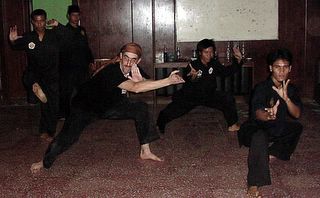
Never Drop Your Guard Around Tuhon!
We had a fantastic discussion in class last week, after a beginning student asked me to elaborate on how Pekiti Tirsia tactics apply to a typical violent encounter on the street (as if there is a such thing as a 'typical' violent encounter.) What was clarified in the course of that discussion, is the unique mentality of the Filipino martial artist in his approach to combat.
I had prepared a transcript of sorts from memory of the points we talked about with the intention of publishing them here. However, I first ran it by another student of mine who is a criminal defense attorney - and he advised against it for several reasons. On reflection, it might not be prudent to discuss such sensitive issues as one's personal resolutions on combat in a public forum. Lets just say that I'll follow Ollie North and Dave Chapelle - and plead the 5th.
I have studied FMA since 1987 with various teachers, each having a unique approach to actual combative applications. To someone coming from a radically different orientation, as in the more mainstream martial arts, this is a completely different world, so to speak. Boxers, grapplers, and Karateka have a very well-defined idea of how, when, and why they will apply their respective disciplines. But if you are a FMA practitioner - true to the tradition of your Art - ask yourself exactly WHAT are you training for with those sticks and blades? Why, when, and how will you use it?
Of all those teachers I trained with, none had a mental format of their system quite similar to Tuhon Gaje. Pekiti Tirsia is more than a weapon, a technique, or a characteristic drill or way of moving. Pekiti Tirsia is a mentality. Those practitioners who are considered to be on a particularly high level in this system understand this. This is not something I have seen Tuhon actually teach during lessons, though he may discuss it over coffee afterwards. There is a scene in the movie Hero, where the protagonist explains that he was able to figure out a rival swordsmans "game" by observing the way he did calligraphy. Take a lesson from that. When you watch Tuhon Gaje give several radically different interpretations of a single technique or drill, you can either come away confused...or you can gain some insight into the unique Pekiti Tirsia mentality which powers ALL of our techniques. Think on this! Even a rank beginner can appreciate the level of Tuhon Gaje's technical mastery. But only when you understand the Mind that brings it forth, will you even begin to appreciate Tuhon's true genius. That's all I'll say on that. Are you with me Ungyo?
On another note, I want to send my blessings and best wishes for the New Year to all of our friends, students, teachers, and supporters. This has been without question our greatest year yet. We've made friends across continents, opened new doors, learned a helluva lot, and most importantly come together as the tightest group of comrades-in-arms I have ever had the honor to be associated with. 2006 has every indication of being even better. We have taken this year out with a monsterous bang, and we'll come out hitting full-force next year - God Willing!
God Bless You All!
JD



